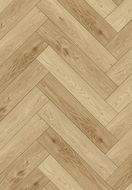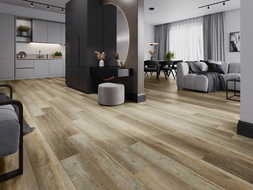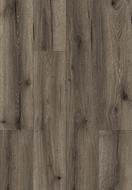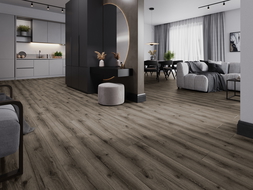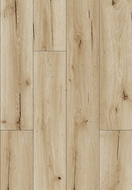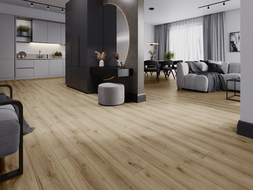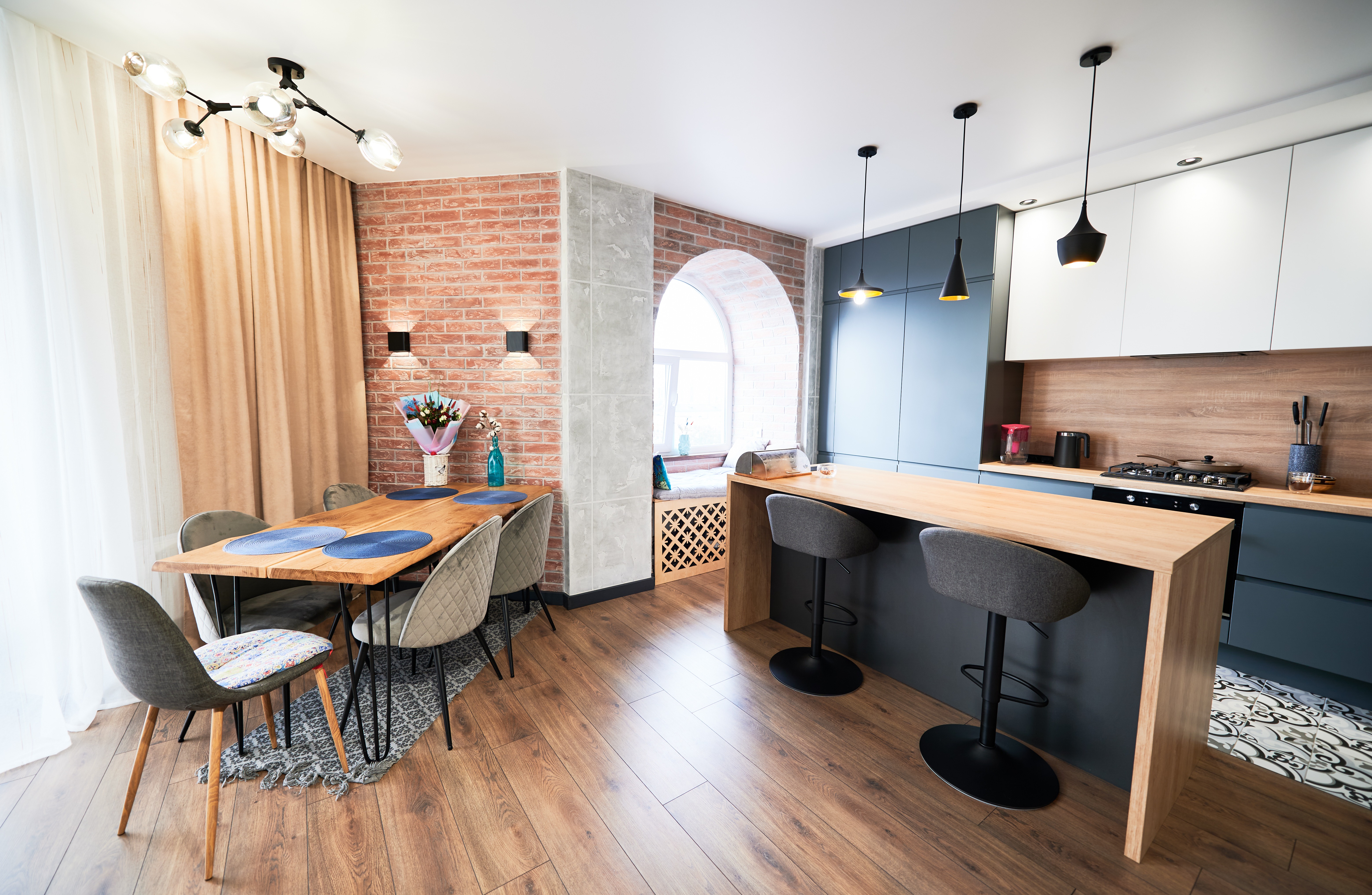
The floor in the kitchen is more prone to various damages than floors in other rooms. Spilled water, oil, or hot soup, a dropped heavy pot, or a sharp knife, all can cause the flooring to get damaged. To prevent this, an appropriate floor finishing method should be chosen. Natural wood is beautiful but not very practical, and many people are already tired of ceramic tiles. We suggest what panels to choose for the kitchen. Modern laminated or vinyl floor panels are an excellent alternative to well-known solutions so far. Such panels are best suited for household use, though they also adorn the floors of public facilities.
What will you learn from this article?
- What types of panels are distinguished.
- What are their characteristics.
- In what situations they work best.
Elegant floor panels for the kitchen
Floor panels are often associated with furnishing the living room or bedroom, perhaps the hallway. However, modern waterproof floor panels are also perfect as a cladding for the kitchen floor. Nowadays, we have a wide choice of various floor panels that differ not only in colors and sizes but also in the material they are made from. The most commonly chosen kitchen floor panels include:
- laminated panels,
- vinyl panels,
- cork panels,
- wooden panels.
You can easily find high-quality floor panels that will match your preferences and the style in which your kitchen is arranged. Floor panels made from modern materials are available in a very wide range of colors – alongside natural wood tones, you will also find kitchen panels imitating stone tiles or even raw concrete. Choosing floor panels should not cause you much difficulty.
What floor panels to choose for underfloor heating?
When choosing floor panels for the kitchen, several aspects should be considered, one of the more important ones being underfloor heating. Contrary to what many people think, there are no contraindications to installing floor panels on underfloor heating. This is one of the reasons why vinyl or laminated floor panels are better than the classic solutions like wooden panels or ceramic tiles.
With underfloor heating, both laminated and vinyl panels can be used. Manufacturers often include information on this on the packaging of the panels. If you do not opt for products dedicated to this type of heating, the only thing to really keep in mind here is the thickness of the floor panels. The thinner they are, the better they conduct heat; thus, an optimal thickness will not exceed 8 mm. Unless you choose vinyl panels – these practically in any variant work well with underfloor heating.
What to remember when choosing panels for the kitchen?
Each package of floor panels has markings that inform about the most important features characterizing a given type of panel. When buying kitchen floor panels, you should pay attention to features such as the abrasion class of the panels and their utility class. These determine the panels' resistance to mechanical damage. As for thickness, the thicker they are, the more durable and stable. On the market, laminated and vinyl panels range from 6 to 12 mm in thickness. It is also worth getting to know the other basic parameters.
- Regarding abrasion class, we deal with a scale described from AC1 to AC5. Those with the lowest number are suitable for residential rooms with low foot traffic, e.g., a bedroom or wardrobe. The higher the abrasion class, the more resistant the panels are to wear; for a kitchen, vinyl panels with an abrasion class specified as AC4 are ideally suited.
- The utility class also describes the level of foot traffic that laminated and other floor panels are adapted to. The utility classes are determined using two digits: the numbers are 21, 22, 23, 31, 32, and 33. A 2 at the beginning indicates they are for residential use, while a 3 indicates they are intended for public utility spaces. The second digit in each of the mentioned numbers corresponds to the intensity of the room's use.
What panels for the kitchen will work best? Which ones to choose?
A wooden floor looks beautiful, but natural wood requires special care. A good alternative to wood may be a laminated floor or one composed of vinyl panels. A panel pattern that excellently mimics real wood will bring a cosy atmosphere to the kitchen, and at the same time, vinyl or laminated floor panels are incredibly easy to keep impeccably clean.
Laminated panels
Laminated kitchen, bathroom, and all other floor panels make the room finished with their help look truly elegant. The wide range of colors makes finding panels tailored to individual preferences almost effortless.
Good panels installed in the right way will surely serve you for many years, becoming a real beauty asset to your home. When choosing them, pay attention to the descriptions on the panel packaging, as not all are suitable for laying on underfloor heating, nor are they all resistant to water action. Poorly chosen ones may be damaged due to moisture.
Vinyl panels
The best panels for the kitchen are those made of solid vinyl. The most important feature is their waterproof quality; the upper layer of the panels prevents water absorption, which means that even a puddle of water cannot damage the panels. The resistance to moisture makes them the best choice not only for the kitchen but also for the bathroom.
The best floor panels
It is hard to pinpoint the best kitchen panels because much depends on the taste of their future owners. However, when choosing them, it is worth paying attention to whether they are completely waterproof and what abrasion class they are marked with. Kitchen panels should be marked with a high abrasion class, as only such panels work well in heavily used spaces, and additionally, they must be resistant to mechanical damages. This way, you will not worry about something happening to them in case of spilling a glass of water or dropping a heavy object onto the floor.
Unsure about which kitchen panels will work well in your case? Ask the specialists from Mexen. Also, check out our blog, where we write, among other topics, about how to save water in the shower.
Additional information and advice
There are many opinions online about kitchen floor panels – kitchen floor panel reviews often highlight their durability and ease of installation. Users particularly praise waterproof models, such as waterproof floor panels for the kitchen, that are ideal for moisture-prone spaces. If you are wondering whether to lay panels under cabinets in the kitchen, the answer is: it depends. Experts suggest omitting laying panels under fixed kitchen furnishings, which saves material and facilitates possible future flooring replacement. However, for movable furniture, it may be worth considering full floor coverage to maintain a cohesive look.
In terms of choosing the best panels, it is advisable to consider not only aesthetics but also technical parameters. Models with a utility class of 3/1 (e.g., 31) are an excellent compromise between durability and price, ideal for intensively used kitchens. Regardless of whether you opt for laminate or vinyl, remember the proper underlay – it is the key to the longevity of your floor. If you have doubts, seek inspiration on our blog!



















